CONFUSING ATTACKS
(Tilting the Balance when your Opponent is Equal in Skills and Techniques)
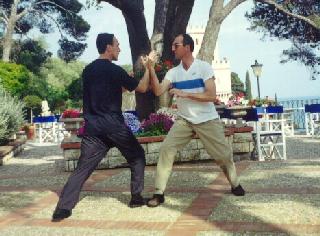
Editorial Note: This is originally meant to be a private webpage for students of Shaolin Wahnam Institute. Nevertheless, as there is not much information on Pushing Hands and Striking Hands although they are crucial aspects of Taijiquan, some explanation is given so that other Taijiquan practitioners may also benefit.
As you and your partner continue in your training, you will find that neither of you can push the other off by using the tactic of continuous attacks which you have learnt earlier. This, of course, does not mean the tactic is not efficacious; it indicates that both of you have become more skilful. If you use the tactic on those who have not undergone Pushing Hands systemmatically, you will find you can push them around quite easily.
In order to push your partner around too, you need to have some other advantages he does not have. So you start thinking, "Now we are equal in skills and techniques. What can I do so that I have at least one advantage over him to tilt the balance to my favour?"
This was actually what happened in the past. When martial artists found their equals in their opponents, and therefore could not defeat them, they had to think out ways to tilt the balance. Over time a corpus of such advantagous ways to win combat was developed by martial artists from actual fighting experience, and as such knowledge affected life and death, it was kept secret. We are lucky to inherit such knowledge.
A tactic that developed from the tactic of continuous attacks is the tactic of confusing attacks. When you find that even attacking your opponent continuously does not give you a decisive advantage, you confuse him first before continuing your attack. One example is as follows.
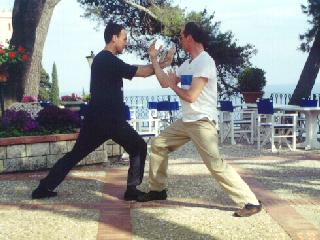
Roberto and Attilio are in the ready position with the "peng" technique.
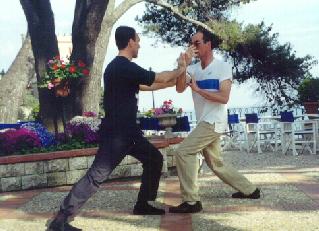
Roberto moves his left back leg a big step forward into a left Bow-Arrow Stance to attack Attilio with a push. Attilio moves his front leg a big step backward into a left Bow-Arrow Stance to neutralize the attack using a "peng" technique.
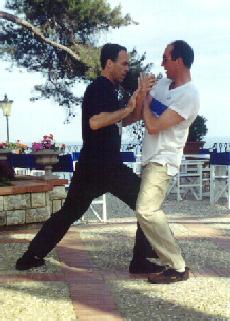
But Roberto's first push was a feign move to confuse Attilio. As soon as Attilio responds to the feign push, Roberto swiftly moves to Attilio's side and executes a real push.
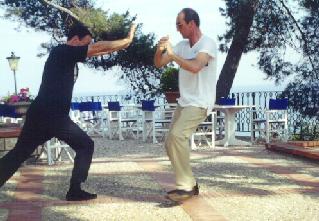
The picture above shows Attilio being pushed away if he fails to respond correctly.

But the response is quite easy. Attilio just moves his left leg backward and wards off the push with a "peng" technique.
The training sequence for the tactic of confusing attack is shown.

|

|

|
When you are familiar with the movement of this sequence, you can try other combinations of movements to confuse your opponent. For example, you feign to move to your right side. When he turns to his left to face your impending attack, you suddenly and swiftly move to your left and push him off. Your moement, of course, must be smooth and spontaneous.
Later, you can use different types of attacks with the tactic of confusing attack. For example, you may move in to feign a push, but instead you execute a strike. Or you may feign a strike above, but actually execute a real attack with a kick below.
Training Points
- It is utmostly important that you yourself must not be confused. You must be very clear of what you wish to do even before initiating your first move.
- The confusing move is not necessarily a feign move; if your opponent cannot respond to your confusing move, you turn it into a real attack.
- The confusing move may not necessarily be the first move. You may use a confusing move in the midst of some real moves.
- Train a particular sequence many times so that you will be fluid and sure in its movement. If you are hasty or hesitant, it is easy for your opponent to turn the table on you.
- When you apply this tactic of confusing attacks on your classmates, they will be able to neutralize your attacks because they are also trained in this tactic. But if you apply this tactic, or any tactic, on the untrained (even they might have practised Taiji forms for decades) you will find you can push them around quite easily. But do not be over-confident, or worse be conceited.
Taijiquan Pushing Hands
-
Series 1 -- Basic Techniques and Skills
-
Series 2 -- Front Attacks and Defence
-
Series 3 -- Right Side Attacks
-
Series 4 -- Left and Back Attacks
-
Series 5 -- Continuous Attacks
-
Series 6 -- Confusing Attacks
-
Series 7 -- Instantaneous Counters
-
Series 8 -- Tactic of Interception
Taijiquan Striking Hands
-
Series 1 -- Basic Striking Attacks and Defence
-
Series 2 -- Seeking Advantages in Striking Attacks
-
Series 3 -- Basic Kicking Attacks and Defence
-
Series 4 -- Seeking Advantages with Kicking Attacks
-
Series 5 -- Felling Attacks and Defence
-
Series 6 -- Reversing Falls
-
Series 7 -- Gripping Techniques
-
Series 8 -- Counters against Gripping Attacks
LINKS
